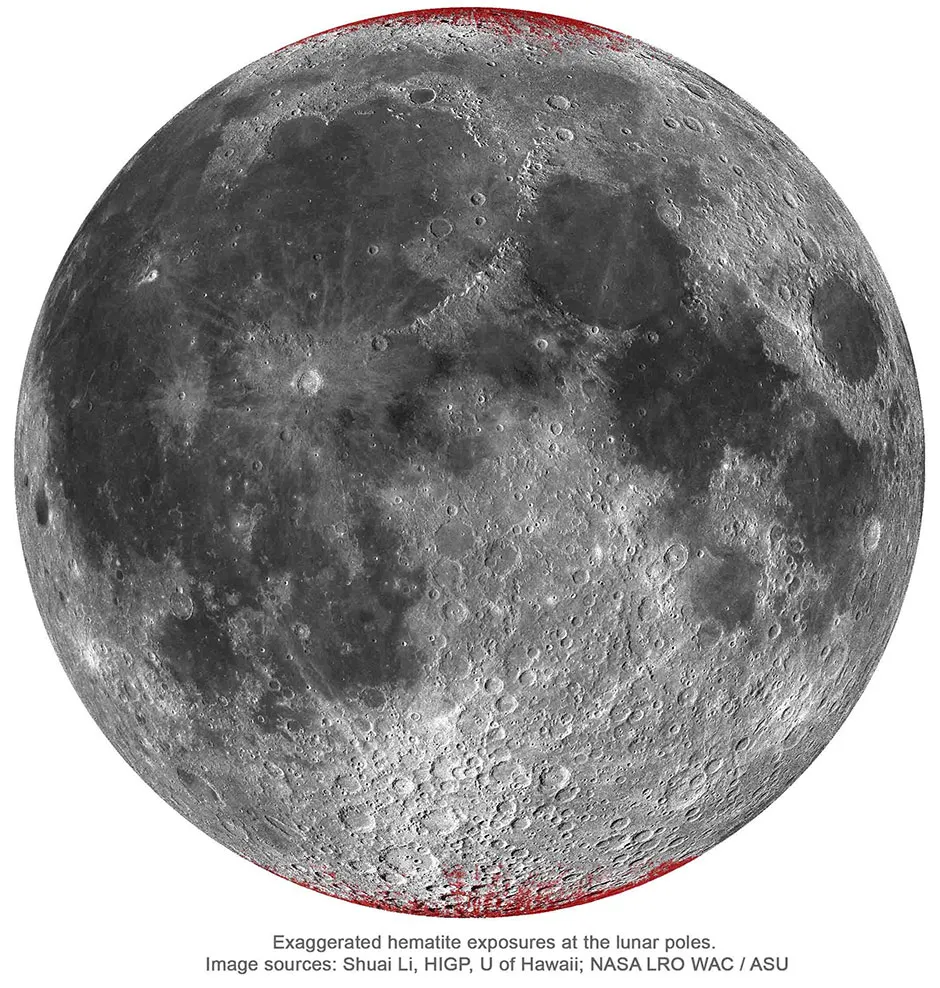Scientists think the Earth’s oxygen may have been rusting the Moon for billions of years.
To the surprise of planetary scientists, the oxidised iron mineral haematite has been discovered at high latitudes on the Moon.
Iron is highly reactive with oxygen, and forms the reddish rust commonly seen on Earth.But the surface and interior of the moon are virtually devoid of oxygen, so pristine metallic iron is prevalent on the Moon and highly oxidised iron has not been confirmed in samples returned from the Apollo missions.
Additionally, hydrogen in solar wind blasts the lunar surface, which acts in opposition to oxidation.Therefore the presence of highly oxidised iron-bearing minerals, such as haematite, on the Moon is an unexpected discovery.
Read more about the Moon:
- The next giant leaps: The UK missions getting us to the Moon
- Entire surface of the Moon mapped for the first time
Lead author Shuai Li, assistant researcher at the Hawai’i Institute of Geophysics and Planetology (HIGP) in the UH Manoa School of Ocean and Earth Science and Technology (SOEST), said: “Our hypothesis is that lunar haematite is formed through oxidation of lunar surface iron by the oxygen from the Earth’s upper atmosphere that has been continuously blown to the lunar surface by solar wind when the Moon is in Earth’s magnetotail during the past several billion years.”
To make this discovery, researchers including co-authors from NASA’s Jet Propulsion Laboratory (JPL) and elsewhere analysed data acquired by the Moon Mineralogy Mapper (M3) designed by NASA JPL onboard India’s Chandrayaan-1 mission.
Prof Li, said: “When I examined the M3 data at the polar regions, I found some spectral features and patterns are different from those we see at the lower latitudes or the Apollo samples.
“I was curious whether it is possible that there are water-rock reactions on the Moon. After months of investigation, I figured out I was seeing the signature of haematite.”

According to the researchers, the locations where haematite is present are strongly correlated with water content at high latitude.
Prof Li added: “More haematite on the lunar nearside suggested that it may be related to Earth. This reminded me of a discovery by the Japanese Kaguya mission that oxygen from the Earth’s upper atmosphere can be blown to the lunar surface by solar wind when the Moon is in the Earth’s magnetotail.
“So, Earth’s atmospheric oxygen could be the major oxidant to produce haematite. Water and interplanetary dust impact may also have played critical roles.”
The study, published in Science Advances, also found that haematite is not completely absent from the far side of the Moon where Earth’s oxygen may have never reached.
Researchers say the small amount of observed at lunar high latitudes may have been substantially involved in the haematite formation process on the lunar far side.
“Earth may have played an important role in the evolution of the Moon’s surface,” Prof Li concluded.
What does lunar dust smell like?
Asked by: Philip Welply, St Albans
Apollo astronauts reported that lunar dust found inside their landers smelt like burnt gunpowder. Since there’s no chemical similarity between moondust and gunpowder, the smell could have been the dust reacting with oxygen and/or water inside the lander, or due to the release of charged particles from the Sun that had become trapped in the dust.
Curiously, though, lunar dust samples brought back to Earth from the Moon are odourless. So whatever caused the smell reported by the Apollo astronauts must have been temporary.
Read more:
